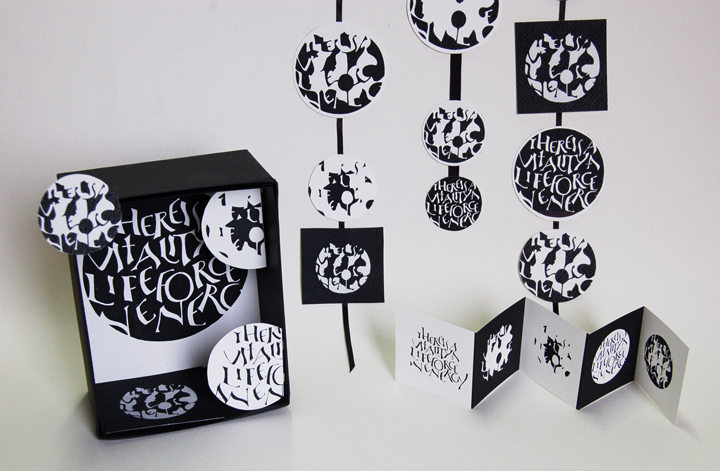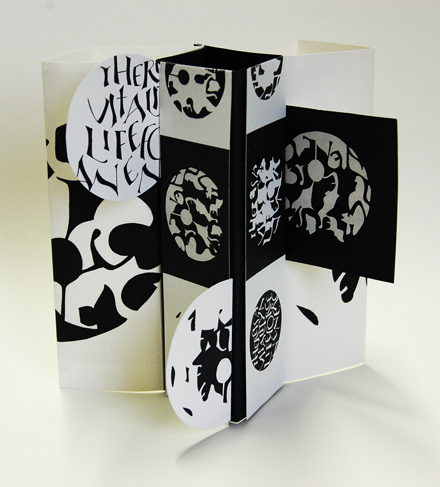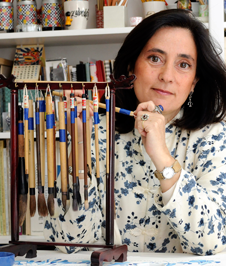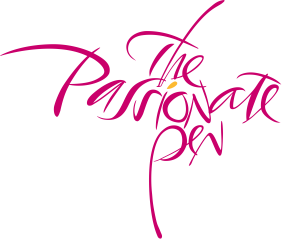Marina Soria
Buenos Aires, Argentina
A44 — The Empty Space, Womb of Shape
One-Day Class, Sunday, July 26
All Levels
Book Arts, Design, Lettering



For eastern art the empty space is the fourth of the principles of the Taoist Rules for Beauty. “Being and not-being complement each other. We mold clay to make pottery, but it is with the empty space where the utility of the jug resides; therefore, we should equally consider what is and what is not.” – Lao Tzu, Tao Te Ching, XI.
The Taoist painters treat the empty space as a positive matter, not as something to be filled in or to spare, but as the origin of form. Considering these rules we will find new ways to work with space. The balance between the use of positive and negative space is key to aesthetic compositions.
This class will start from an experimental alphabet or a formal one with a personal twist and we will work the space issues, trying to accomplish new compositions where space is not the blank portion of the paper.
Venture into a new world of space and prepare to open your mind to a new way of perceiving.
Supply List
- Some of your favorite tools: ruling pen, cola pen, folded pen, Automatic pen, or any other tool you have used to perform your writing
- Medium-sized brushes and a thin one to draw contours or outlines
- Black sumi ink or some tubes of dark color gouache
- White gouache
- Layout paper, preferably lightweight and transparent
- Two sheets of any good quality smooth paper like Rives BFK or Arches 140 lb hot press
- Needle for a simple Japanese binding
- White or black thread
- Awl
- Little clips to hold paper on place while binding
- A straight-edge metallic ruler
- One yard of black ribbon
- A portable light box would be very useful; if not, the classroom windows will work
- Pencil
- Eraser
- Palette for mixing colors
- Paper towels or rags
- Double sided tape
- Scissors, good cutter, or X-acto knife
- Glue stick
- Fiber tip pens for quick writing and contour delineate.
- Small size black box, any you could have at home like the ones the iphone comes in or any of the sort
- Only if you have: a round punch of approximately 2 inches
- A selection of two or three short poems, haikus, quotes, or your own words
- You may also bring your own music with headphones
 Since she was a teenager, Marina Soria has always been deeply seduced by letterforms. Written language is not only a complex system of communication, but the realm of style and form. Expressing perceptions or sensibilities through syntax, letterform and rhythm is the most complete of all messages. In the calligraphic arts, she found the way to convey her inner thoughts and reflections about life.
Since she was a teenager, Marina Soria has always been deeply seduced by letterforms. Written language is not only a complex system of communication, but the realm of style and form. Expressing perceptions or sensibilities through syntax, letterform and rhythm is the most complete of all messages. In the calligraphic arts, she found the way to convey her inner thoughts and reflections about life.
Marina Soria was born in Buenos Aires, Argentina. She has degrees in Fine Arts and Graphic Design. She began lecturing on Graphic Design and Editorial Design in the University of Buenos Aires (UBA), first on a part-time basis and then as an Associate Professor in Typography. In 2008/2009 she taught workshops for postgraduate students at UBA on experimental calligraphy and now lectures on graphic design and typography.
Marina has attended five international calligraphy conferences in the USA and three in Europe, taking courses with Thomas Ingmire, Brody Neuenschwander, Ewan Clayton, and Monica Dengo, among others. In 2003 she was awarded with the ACA‘s scholarship. In 1997 she founded Calígrafos de la Cruz del Sur (Southern Cross Calligraphers), the first calligraphic guild in Argentina and in South America. She has received national and international awards and exhibited her pictorial and calligraphic works in Argentina, Uruguay, U.S., Spain, Japan, Germany, Russia, and Norway. Her works are part of the Contemporary Museum of Calligraphy in Russia, the Hans-Joachim Burgert Collection in Berlin, the Arezzo Public Library in Italy, the Latin American Collection for the Yale University, and the Savannah College of Arts in the U.S.
Marina has published articles in specialized magazines and her work may be seen in LAR Annuals, Bound & Lettered, Novum (Germany), Typo (Mexico), several magazines, and webpages in Argentina. In 2013, her work was extensively featured in LAR: 26:3. At present she works as an experimental calligrapher and a graphic artist, and continues to teach in her own studio and abroad. In April, 2014 she taught and exhibited in Florence, and in July she gave workshops in the U.S. in Portland, Salem, and Los Angeles. Her main interest is to mingle and blend diverse disciplines: art, textile art, graphic design, sumi-e, and calligraphy to challenge the limits of conceptual art and technique. See: www.marinasoria.com.ar and www.facebook.com/calligraphyinblossom
